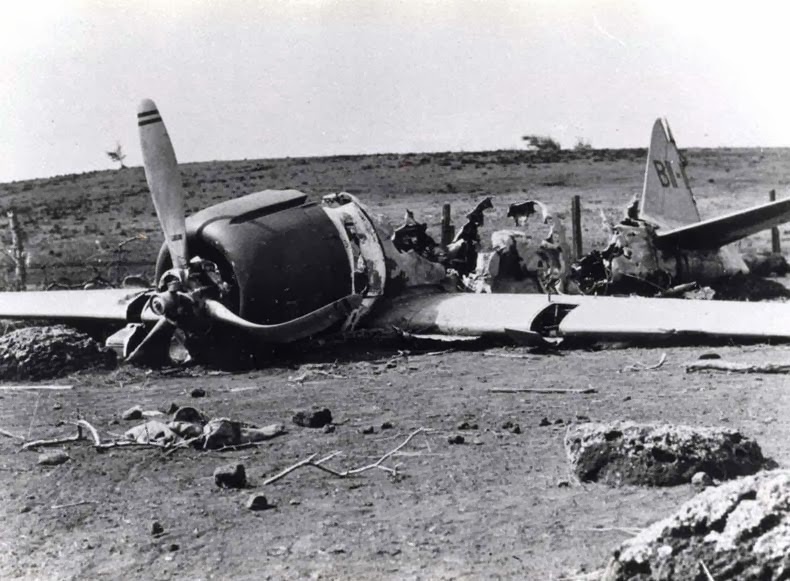The Mitsubishi A6M Zero was a long-range fighter aircraft, manufactured by Mitsubishi Heavy Industries, and operated by the Imperial Japanese Navy from 1940 to 1945. The A6M was designated as the Mitsubishi Navy Type 0 Carrier Fighter (零式艦上戦闘機 rei-shiki-kanjō-sentōki), and also designated as the Mitsubishi A6M Rei-sen and Mitsubishi Navy 12-shi Carrier Fighter. The A6M was usually referred to by its pilots as the "Zero-sen", zero being the last digit of the Imperial year 2600 (1940) when it entered service with the Imperial Navy. The official Allied reporting name was "Zeke", although the use of the name "Zero" was later commonly adopted by the Allies as well.
When it was introduced early in World War II, the Zero was considered the most capable carrier-based fighter in the world, combining excellent maneuverability and very long range. In early combat operations, the Zero gained a legendary reputation as a dogfighter, achieving the outstanding kill ratio of 12 to 1, but by mid-1942 a combination of new tactics and the introduction of better equipment enabled the Allied pilots to engage the Zero on more equal terms.
The Imperial Japanese Navy Air Service ("IJNAS") also frequently used the type as a land-based fighter. By 1943, inherent design weaknesses and the failure to develop more powerful aircraft engines meant that the Zero became less effective against newer enemy fighters that possessed greater firepower, armor, and speed, and approached the Zero's maneuverability. Although the Mitsubishi A6M was outdated by 1944, it was never totally supplanted by the newer Japanese aircraft types. During the final years of the War in the Pacific, the Zero was used in kamikaze operations. In the course of the war, more Zeros were built than any other Japanese aircraft.
As I've mentioned before, I have a number of favorite aircraft. Yes, most of them are fighter aircraft and a great many of them are from World War II. But there is something about the Zero. She's quick and oh so very nimble!
Now this next video is of a Zero, with its original Sakae engine. Pretty rare indeed!
She purrs, doesn't she?
 |
| Somewhere over the Pacific... |
The Niihau Incident
 |
| The Wreckage of Petty Officer Nishikaichi's Zero |
The Japanese planners had determined that some means of rescuing fliers whose aircraft were too badly damaged to return to the carriers was required. The island of Niihau, only 30 minutes flying time from Pearl Harbor, was designated as the rescue point.As the war dragged on and many experienced Japanese pilots lost their lives in the face of overwhelming Allied air power, the Zero took on a newer, more sinister role.
The Zero flown by Petty Officer Shigenori Nishikaichi of Hiryu was damaged in the attack on Wheeler, and he flew to the rescue point on Niihau. The aircraft was further damaged on landing. Nishikaichi was helped from the wreckage by one of the native Hawaiian inhabitants, who, aware of the tension between the United States and Japan, took the pilot's maps and other documents. The island's residents had no telephones or radio and were completely unaware of the attack on Pearl Harbor. Nishikaichi enlisted the support of three Japanese-American residents in an attempt to recover the documents. During the ensuing struggles, Nishikaichi was killed and a Hawaiian civilian was wounded; one collaborator committed suicide, and his wife and the third collaborator were sent to prison.
The Kamikaze (神風, Divine Wind)















They were sweet planes, to be sure. Pity that, like the Me-109 and FW-190, so few of those that survived the war intact were saved.
ReplyDeleteI know. My Dad told me stories of when he was in Germany right after the war, watching tons of equipment (German AND American) being loaded onto ships which then went out to sea dumped their load.
DeleteI cringe when I think of all the cool stuff rusting away under the North Sea and the Baltic!
Sarge, your fly-bys make Fridays just that much better. Thanks again.
ReplyDeleteSeconded.
DeleteI hope they're as enjoyable to read as they are to put together.
DeleteI didn't get started on this one until 2100 Thursday night, figured I'd start it and fill things in at lunch at work on Friday.
One thing led to another. Reading bits and pieces, finding some great photos, then before you know it, it was 2300. And the Flyby was ready to roll.
One thing I found odd though, the scarcity of really good photos from the Japanese perspective.
What juvat said: I enjoy these posts immensely. Thank you!
ReplyDeleteI'm glad you like 'em Rev!
DeleteToo bad there are so few surviving late-war high performance Japanese fighters like the in-line liquid-cooled Kawasaki Ki-61 Hein, the Nakajimi Ki-84 Hayate (looked a lot like a P-47), The Kawanishi N1K-2J "Shiden-Kai" or the Mitsubishi J2m Raiden. (of which only one survives)
ReplyDeleteExcellent points Virgil. The Ki-61 was a favorite of mine as a kid. I had a model of one. A sweet looking bird.
Delete